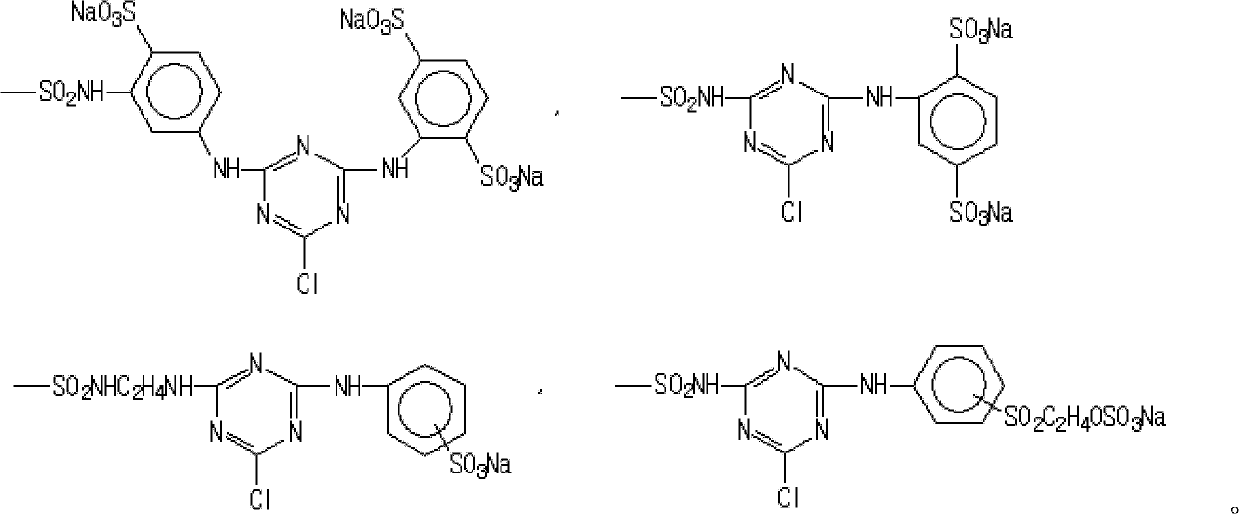Turquoise blue reactive dye as well as preparation method and application thereof
A reactive dye and blue technology, applied in the direction of reactive dyes, dyeing methods, azo dyes, etc., can solve the problems of large average particle size, high salt content, low coloring rate, etc., to achieve small average particle size, The effect of low salt content and high coloring rate
- Summary
- Abstract
- Description
- Claims
- Application Information
AI Technical Summary
Problems solved by technology
Method used
Image
Examples
Embodiment 1
[0041] a. Chlorosulfonation reaction, ice out
[0042] Add 1750 kg of chlorosulfonic acid in the enamel tank, cool down with circulating cold water, and control the temperature at 40-50°C. It took 2 hours to add copper phthalocyanine. Adjust the temperature to 128°C, maintain the temperature at 128-130°C, and react for 4 hours. Adjust the temperature to 65°C, maintain the temperature at 65-70°C, and add 560 kg of thionyl chloride in 2 hours. Maintain the temperature at 65-70°C and react for 2 hours. Adjust the temperature to 90°C, maintain the temperature at 90-95°C, and react for 1 hour. Adjust the temperature to 105°C. Maintain the temperature at 105-110°C and react for 1 hour.
[0043] Adjust the temperature to 20-25°C, add the obtained chlorosulfonation feed liquid into the ice-out tank in a thin stream, and control the temperature. Over 2 hours, the chlorosulfonation feed solution was added. Maintain the temperature at -5-5°C and stir for 1 hour. Add the deicing li...
Embodiment 2
[0074] a. Chlorosulfonation reaction, ice out
[0075] Add 1,750 kg of chlorosulfonic acid to the enamel tank. Circulate cold water to lower the temperature, and control the temperature to 40-50°C. It took 2 hours to add copper phthalocyanine. Adjust the temperature to 128°C, maintain the temperature at 128-130°C, and react for 4 hours. Adjust the temperature to 60°C, maintain the temperature at 60-65°C, and add 525 kg of thionyl chloride in 1.5 hours. Maintain the temperature at 60-65°C and react for 2 hours. Adjust the temperature to 90°C, maintain the temperature at 90-95°C, and react for 1 hour. Adjust the temperature to 100°C. Maintain the temperature at 100-105°C and react for 2 hours.
[0076] Adjust the temperature to 25-30°C, add the obtained chlorosulfonation feed liquid into the ice-out tank in a thin stream, and control the temperature. Over 2 hours, the chlorosulfonation feed solution was added. Maintain the temperature at 0-5°C and stir for 1 hour. Add the...
Embodiment 3
[0108] a. Chlorosulfonation reaction, ice out
[0109] Add 1,750 kg of chlorosulfonic acid to the enamel tank. Circulate cold water to lower the temperature, and control the temperature to 40-50°C. It takes 2 hours to add copper phthalocyanine. Adjust the temperature to 120°C, maintain the temperature at 120-125°C, and react for 4 hours. Adjust the temperature to 65°C, maintain the temperature at 65-70°C, and add 490 kg of thionyl chloride in 2 hours. Maintain the temperature at 65-70°C and react for 2 hours. Adjust the temperature to 90°C, maintain the temperature at 90-95°C, and react for 1 hour. Adjust the temperature to 105°C. Maintain the temperature at 105-110°C and react for 2 hours.
[0110] Adjust the temperature to 10-15°C, add the obtained chlorosulfonation feed liquid into the ice-out tank in a thin stream, and control the temperature. Over 2 hours, the chlorosulfonation feed solution was added. Maintain the temperature at 5-15°C and stir for 1 hour. Add the...
PUM
 Login to View More
Login to View More Abstract
Description
Claims
Application Information
 Login to View More
Login to View More - R&D
- Intellectual Property
- Life Sciences
- Materials
- Tech Scout
- Unparalleled Data Quality
- Higher Quality Content
- 60% Fewer Hallucinations
Browse by: Latest US Patents, China's latest patents, Technical Efficacy Thesaurus, Application Domain, Technology Topic, Popular Technical Reports.
© 2025 PatSnap. All rights reserved.Legal|Privacy policy|Modern Slavery Act Transparency Statement|Sitemap|About US| Contact US: help@patsnap.com



